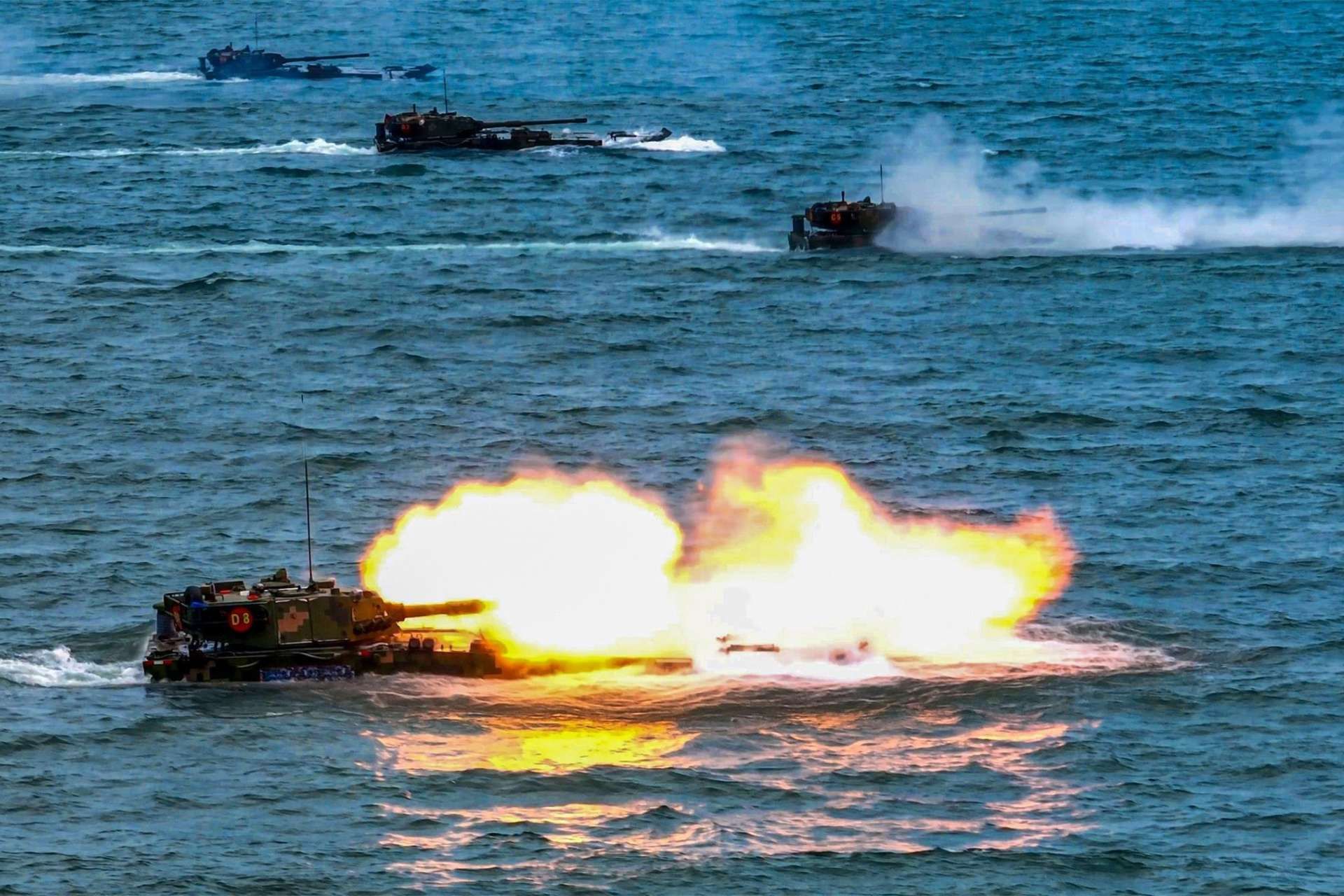Breaking news
Inauguration of Taiwan's New Leader Amid Increased Pressure from China.
As Taiwan prepares for the inauguration of President-elect Lai Ching-te on May 20, the island anticipates heightened provocations from Beijing. Lai's election, perceived as strongly opposed to China, triggered a sharp response from the Chinese government. The Chinese Foreign Ministry reiterated that Lai's presidency does not alter their stance that Taiwan is part of a singular China.
Follow Army Recognition on Google News at this link

Amphibious assault vehicles attached to a brigade under the PLA 73rd Group Army fire at mock targets during a live-fire training exercise in 2023 (Picture source: China MoD)
Geopolitical tensions between China and Taiwan are escalating, marked by frequent Chinese military activities near Taiwan. Throughout 2023, over 1,700 Chinese aircraft breached Taiwan's Air Defense Identification Zone (ADIZ), with 703 of these incursions crossing the median line of the Taiwan Strait. The intrusions included a variety of fighter jets, bombers, drones, and spy balloons, showcasing persistent Chinese military pressure. Moreover, Chinese warships and aircraft carriers regularly maneuver around Taiwanese waters, further intensifying regional tensions.
In this context, the United States has expressed its support for Taiwan, reaffirming its commitment to assist Taiwan in defending against aggressions. This support is vital as Taiwan faces growing threats, particularly from naval and aerial intrusions. To counter these provocations effectively, Taiwan is adapting its defense strategies. Frequent violations by Chinese military aircraft require swift responses from Taiwanese officials, who often have just minutes to react due to the proximity of Chinese forces. This situation has necessitated changes in how Taiwan’s Ministry of National Defense communicates incidents to enhance clarity and reduce public confusion about these geopolitical tensions.
The challenges of maintaining a robust defense are compounded by regular sightings of Chinese vessels near Taiwanese waters, including combat ships and potentially submarines, raising the stakes for any military misunderstanding or escalation. Taiwan's strategic response has evolved from intercepting each incursion to a more measured approach, focusing on tracking Chinese aircraft with surface-to-air missiles and issuing radio warnings. This shift reflects both the financial burden of continuous interceptions and the wear on Taiwan's limited fleet of military aircraft.
To improve its defensive posture, Taiwan now prioritizes transparency and timeliness in its military reports. These reports aim to provide clear and detailed information about Chinese military activities, keeping local and international communities well-informed about the challenges Taiwan faces. This approach not only helps manage domestic concerns but also aids in gathering international support against the threats posed by Chinese military maneuvers near the island.
Although well-trained, Taiwan’s military is substantially outclassed by Chinese forces. Taiwan's air force notably includes upgraded F-16 fighters, and Taiwan has recently begun receiving new F-16V Viper jets, enhanced versions capable of carrying a variety of advanced weapons and equipped with the latest generation radars. Taiwan also has its own combat tanks, the locally designed and manufactured CM-32 "Clouded Leopard," capable of operating in various island environments. On the naval front, Taiwan is modernizing its fleet with the acquisition of submarines and frigates capable of countering enemy submarines and surface ships. Additionally, Taiwan regularly conducts island defense simulations, including sea invasion scenarios, where armed forces practice coastal defense maneuvers and rapid counter-attack operations. These exercises aim to strengthen Taiwan’s preparedness for a hypothetical invasion, improving coordination among different military branches and testing combat strategies in real-life situations.
Conversely, China boasts one of the world's largest and most advanced armies, with significant capabilities in all areas of modern warfare. The People's Liberation Army (PLA) includes a massive land force equipped with the latest generation tanks such as the Type 99, along with a broad range of armored vehicles. The PLA also possesses formidable aerial capabilities, with advanced fighters such as the Chengdu J-20, a fifth-generation aircraft designed to compete with American stealth jets. The Chinese navy has undergone substantial development and modernization, including guided missile destroyers, nuclear and conventional submarines, and aircraft carriers like the Liaoning and Shandong, which extend the reach of China's projectable force.
China’s long-range strike capability is also noteworthy, with an arsenal of ballistic and cruise missiles capable of targeting Taiwan from the mainland. This includes missiles like the DF-16, specifically designed to reach targets in Taiwan, capable of carrying conventional and nuclear payloads. Additionally, China continues to develop its amphibious warfare capabilities, with vessels like the Type 071, a Yuzhao-class landing ship, enabling the rapid deployment of troops and equipment onto beaches in conflict scenarios.
This complex military dynamic between Taiwan and China underscores the need for Taiwan to continually maintain and enhance its defense capabilities while seeking international support to deter potential aggression. From an economic perspective, Taiwan's semiconductor production reinforces allied nations' support intentions, even as several Taiwanese companies build facilities in the United States with the aim of filling the void created by a potential Chinese invasion.
Taiwan’s new President, Lai Ching-te, thus confronts a complex scenario under constant threat from China, necessitating the maintenance of national security and economic stability.


























